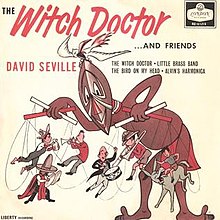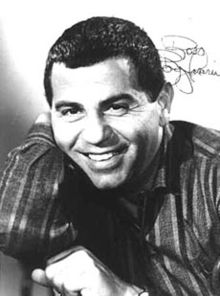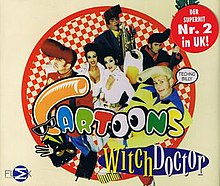Witch Doctor (song)
| "Witch Doctor" | ||||
|---|---|---|---|---|
 | ||||
| Single by Ross Bagdasarian | ||||
| from the album Sing Again with The Chipmunks | ||||
| B-side | "Don't Whistle at Me, Baby" | |||
| Released | April 1958 | |||
| Genre | ||||
| Length | 2:15 | |||
| Label | Liberty | |||
| Songwriter(s) | Ross Bagdasarian | |||
| Producer(s) | Ross Bagdasarian | |||
| Ross Bagdasarian singles chronology | ||||
| ||||
"Witch Doctor" is a 1958 American novelty song written and recorded by Ross Bagdasarian (under the stage name of David Seville). Bagdasarian sang the song, varying the tape speeds to produce a high-pitched voice for the titular witch doctor;[1][2] this technique was later used in his next song, "The Bird on My Head",[3][4][5] and for the creation of the voices of his virtual band Alvin and the Chipmunks. The song became a number one hit and rescued Liberty Records from near-bankruptcy;[6] it held number one for three weeks in the Billboard Hot 100 chart,[7][8] ranked by Billboard as the No. 4 song for 1958.[9][10]
In the song, the narrator asks a witch doctor for romantic advice because he has fallen in love with a girl; the witch doctor responds in a high-pitched, squeaky voice with a nonsense incantation which creates an earworm: "Oo-ee-oo-ah-ah, ting-tang, walla-walla, bing-bang, oo-ee-oo-ah-ah, ting-tang, walla-walla, bing-bang".
History
[edit]
Ross Bagdasarian, a Broadway actor who had been a pianist in Alfred Hitchcock's 1954 masterpiece Rear Window, wrote the song, inspired by a book titled Duel with a Witch Doctor on his bookshelf. Bagdasarian had spent $200, a significant sum at that time, on a specialized tape recorder;[11] while experimenting with the device, he had an idea of recording his voice at a different speed to create a dialogue between himself and the witch doctor. He sang in his own voice as normal, and then overdubbed the song with the voice of the "witch doctor", which is in fact his own voice sung slowly but recorded at half speed on the tape recorder, then played back at normal speed (the voice was therefore sped up to become a high-pitched, squeaky one).[4][5] Bagdasarian recorded the music first, and then experimented with the process for creating the singing voice for two months before recording it in the studio.[4][12] It was said that when Si Waronker from the financially-troubled Liberty Records label heard the resulting song, they released it to reach the shops within 24 hours.[13]
The same technique used to create the voice of the witch doctor was used in Bagdasarian's next song "The Bird on My Head", and then more significantly the highly successful Alvin and the Chipmunks, beginning with "The Chipmunk Song (Christmas Don't Be Late)" released for Christmas 1958.[5] Initially released under David Seville alone, "Witch Doctor" was also released under the name of David Seville and the Chipmunks and re-recorded under the name Alvin and the Chipmunks. The technique was also imitated by other recording artists, such as Sheb Wooley in "The Purple People Eater".[12] The Big Bopper parodied both songs on "The Purple People Eater Meets the Witch Doctor"; this song was originally released as a single, but it was its flip-side "Chantilly Lace" that became the hit.[14]
Chart performance
[edit]"Witch Doctor" peaked at No. 1 on the Billboard Top 100, the predecessor to the Billboard Hot 100. The single was considered a major surprise hit on the chart, where it became Ross Bagdasarian and Liberty Records' first No. 1 single, and stayed in the position for three weeks. The single also peaked at No. 1 on the Billboard R&B chart even though it is not a R&B song – this is due to the R&B chart being a trade category at the time, reflecting the popularity of the song with African-American radio stations and customers.[15] The single had sold 1.4 million copies in the United States by December 1958.[16] Billboard ranked it as the No. 4 song for 1958.[17]
Charts
[edit]| Chart (1958) | Peak position |
|---|---|
| Canada (CHUM Hit Parade)[18] | 1 |
| UK Singles (OCC)[19] | 11 |
| US Top 100 Sides (Billboard)[20] | 1 |
| US Billboard Rhythm & Blues Records[21] | 1 |
| US Cash Box Top 100[22] | 1 |
Cover versions
[edit]Alvin and the Chipmunks versions
[edit]The song has gained further popularity due to multiple covers performed by Alvin and the Chipmunks, another Ross Bagdasarian creation. The first one was for their 1960 album Sing Again with The Chipmunks, which would be released as a single and adapted into a musical segment in The Alvin Show, which in turn was included on the eponymous soundtrack of the animated series. In 1983, they performed the song on the Alvin and the Chipmunks episode "The Chipmunk Story" and for their 1984 album Songs from our TV Shows. The Chipmunk Adventure also features the song, this time sung by Mrs. Miller. The song was used for the opening of the 1990 TV special Rockin' Through the Decades in the style of various artists.
In 2007, a DeeTown remix cover featuring Chris Classic was recorded for the live-action/CGI film Alvin and the Chipmunks. This version reached No. 62 on the Billboard Hot 100 in January 2008.[23]
Cartoons version
[edit]| "Witch Doctor" | ||||
|---|---|---|---|---|
 | ||||
| Single by Cartoons | ||||
| from the album Toonage | ||||
| Released | October 26, 1998 | |||
| Recorded | 1998 | |||
| Genre | Eurodance | |||
| Length | 3:06 | |||
| Label | ||||
| Songwriter(s) | Ross Bagdasarian | |||
| Producer(s) |
| |||
| Cartoons singles chronology | ||||
| ||||
| Music video | ||||
| "Witch Doctor" on YouTube | ||||
Danish band Cartoons covered "Witch Doctor" for their 1998 debut album, Toonage. Released on October 26, 1998, their version charted well in Europe, reaching the Top 40 in several countries, and peaking at No. 2 on the UK Singles Chart in March 1999.[24]
Music video
[edit]The accompanying music video for the group's version features both live-action and 2D animation, and depicts them (as "the Cartoons", as shown on the title card) visiting a witch doctor. Lead singer Toonie urges the rest to see him, but they are all reluctant. He asks the witch doctor to give them the "magic words" (i. e. the famous nonsensical lyric), which the latter does, after which the group enters the house and follows the witch doctor into a TV and out the back, where they fall off a cliff but miraculously land unharmed on the ground. They all get into a ship shaped like a giant microphone, called "Toontanic" (based on the Titanic), and fly through the sky, underwater and in space. At this point, the video starts showing sexual themes, contrasting the cartoon theme. The rod-shaped spaceship flies into a hole, and then, bumps into a sphere, appearing to imitate a sperm fertilizing an egg. The witch doctor transforms into Elvis Presley, drops them off atop a building with a sign that reads "Toonie-Wood", declares his love for the band and says goodbye before leaving the place.[25]
Track listings
[edit]| No. | Title | Length |
|---|---|---|
| 1. | "Witch Doctor" (Radio Mix) | 3:06 |
| 2. | "Witch Doctor" (Extended Mix) | 4:14 |
| 3. | "Witch Doctor" (Out of Africa Remix) | 5:09 |
Release history
[edit]| Region | Date | Format(s) | Label(s) | Ref. |
|---|---|---|---|---|
| Denmark | October 26, 1998 | CD | [26] | |
| United Kingdom | March 22, 1999 |
|
[27] |
Charts
[edit]
Weekly charts[edit]
|
Year-end charts[edit]
|
Certifications
[edit]| Region | Certification | Certified units/sales |
|---|---|---|
| United Kingdom (BPI)[43] | Platinum | 600,000‡ |
|
‡ Sales+streaming figures based on certification alone. | ||
Other versions
[edit]- English trombonist and singer Don Lang recorded a version similar to Ross Bagdasarian's recording. This cover reached No. 5 on the UK chart in June 1958.[44]
- Mexican actor and comedian Manuel "El Loco" Valdés performed a Spanish version of the song for the 1958 film Two Ghosts and a Girl, where he plays various stereotypical roles of African, German, Spanish, Russian and Chinese people. The performance was very well received by the Mexican public and is considered a classic of Mexican comedy. Manuel Valdés would reinterpret the song in other productions throughout his career, including the 2007 animated film La Leyenda de la Nahuala.[45]
- New wave band Devo recorded a version for the soundtrack of The Rugrats Movie. The verses were changed to be about how monkeys have more fun than humans.[46]
References
[edit]- ^ ""The Chipmunk Song" Turns 60: Secrets of a Holiday Novelty Smash". The Hollywood Reporter. December 21, 2018. Retrieved October 28, 2024.
- ^ "Justice For "The Chipmunk Song": 10 Reasons It Will Always Be A Christmas Classic". Grammy Awards. Retrieved November 20, 2024.
- ^ Kelly, Michael Bryan (1993). Liberty Records: A History of the Recording Company and Its Stars, 1955–1971. McFarland. p. 44. ISBN 9780899507408.
- ^ a b c Bronson, Fred (1997). The Billboard Book of Number One Hits. Billboard Books. p. 36. ISBN 9780823076413.
- ^ a b c The Oxford Handbook of Music and Virtuality. Oxford University Press. 2016. p. 132. ISBN 9780199321285.
- ^ "How David Seville and The Witch Doctor Rescued Liberty Records". Black Gold Brooklyn. October 11, 2017. Archived from the original on July 28, 2020.
- ^ "Chipmunk: Lighting Can Strike Twice". Billboard. December 1, 1958. p. 11.
- ^ Ripani, Richard J. (2009). The New Blue Music: Changes in Rhythm & Blues, 1950–1999. University Press of Mississippi. ISBN 9781496801289.
- ^ "Number One Song of the Year: 1946–2014". Bob Borst's Home of Pop Culture. March 9, 2023.
- ^ "The Number Ones: The Chipmunks & David Seville's "The Chipmunk Song (Christmas Don't Be Late)"". Stereogum. Retrieved December 4, 2024.
- ^ Kelly, Michael Bryan (1993). Liberty Records: A History of the Recording Company and Its Stars, 1955-1971. McFarland. p. 44. ISBN 9780899507408.
- ^ a b Tyler, Don (2008). Music of the postwar era. Greenwood Press. p. 99–100. ISBN 9780313341915.
- ^ Cotten, Lee (1995). Reelin' and Rockin': The Golden Age of American Rock 'N Roll 1956-1959. Pierian Press. p. 274. ISBN 9781560750390.
- ^ Cooper, B. Lee; Haney, Wayne S. (1995). Rock Music in American Popular Culture: Rock 'n' Roll Resources. Vol. 1. Haworth Press. p. 258. ISBN 9781560248613.
- ^ Ripani, Richard J. (2009). The New Blue Music: Changes in Rhythm & Blues, 1950–1999. University Press of Mississippi. ISBN 9781496801289.
- ^ "Chipmunk: Lighting Can Strike Twice". Billboard. December 1, 1958. p. 11.
- ^ "Number One Song of the Year: 1946–2014". Bob Borst's Home of Pop Culture. March 9, 2023.
- ^ "CHUM Hit Parade, week of April 28, 1958".
- ^ "Official Singles Chart Top 100". Official Charts Company.
- ^ "Top 100 Sides". Billboard. May 12, 1958. p. 36.
- ^ Whitburn, Joel (2004). Top R&B/Hip-Hop Singles: 1942-2004. Record Research. p. 148.
- ^ "Cash Box Top 100 Singles, May 10, 1958".
- ^ "Billboard Hot 100". Billboard. January 12, 2008. p. 46.
- ^ a b "Official Singles Chart Top 100". Official Charts Company. Retrieved November 8, 2021.
- ^ Witch Doctor - Cartoons (Official Music Video) | Warner Vault. YouTube. Warner Records Vault. December 19, 2017. Retrieved August 6, 2023.
- ^ "Cartoons – Witch Doctor (1998)". Maniadb.com. Retrieved April 27, 2021.
- ^ "New Releases – For Week Starting 22 March, 1999" (PDF). Music Week. March 20, 1999. p. 27. Retrieved July 19, 2021.
- ^ "Cartoons – Witch Doctor" (in Dutch). Ultratop 50.
- ^ "Eurochart Hot 100 Singles" (PDF). Music & Media. Vol. 16, no. 15. April 11, 1999. p. 8. Retrieved May 1, 2020.
- ^ "Cartoons – Witch Doctor" (in French). Les classement single.
- ^ "Cartoons – Witch Doctor" (in German). GfK Entertainment charts. Retrieved May 1, 2020.
- ^ "Nederlandse Top 40 – week 25, 1999" (in Dutch). Dutch Top 40.
- ^ "Cartoons – Witch Doctor" (in Dutch). Single Top 100.
- ^ "Cartoons – Witch Doctor". Top 40 Singles.
- ^ "Official Scottish Singles Sales Chart Top 100". Official Charts Company. Retrieved November 8, 2021.
- ^ "Cartoons – Witch Doctor". Singles Top 100.
- ^ "Jaaroverzichten 1999" (in Dutch). Ultratop. Retrieved March 12, 2020.
- ^ "Eurochart Hot 100 Singles 1999" (PDF). Music & Media. Retrieved September 13, 2022.
- ^ "Top 100–Jaaroverzicht van 1999". Dutch Top 40. Retrieved March 12, 2020.
- ^ "Jaaroverzichten – Single 1999" (in Dutch). MegaCharts. Retrieved March 12, 2020.
- ^ "Yearly Best Selling Singles" (PDF). British Phonographic Industry. Archived from the original (PDF) on September 24, 2010. Retrieved February 28, 2021.
- ^ "Best Sellers of 1999: Singles Top 100". Music Week. London, England: United Business Media. January 22, 2000. p. 27.
- ^ "British single certifications – Cartoons – Witch Doctor". British Phonographic Industry. Retrieved May 1, 2020.
- ^ "Don Lang". The Official Charts Company.
- ^ "La historia de cuando "El Loco" Valdés fue un esqueleto bailarín". El Universal (in Spanish). Retrieved May 27, 2024.
- ^ "The Rugrats soundtrack to receive first ever vinyl release". November 27, 2018.
- 1958 songs
- 1958 debut singles
- 1998 singles
- Alvin and the Chipmunks songs
- Bertelsmann Music Group singles
- Billboard Top 100 number-one singles
- Cartoons (band) songs
- Cashbox number-one singles
- EMI Records singles
- Liberty Records singles
- Music published by Bourne Co. Music Publishers
- Novelty songs
- Songs about physicians
- Songs written by Ross Bagdasarian
- Universal Records singles
- Warner Records singles
